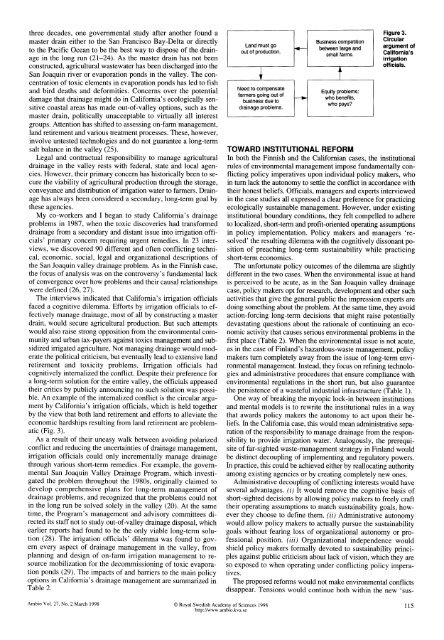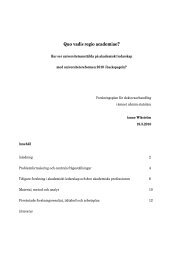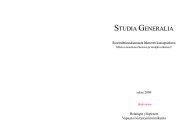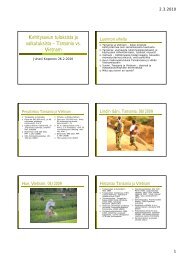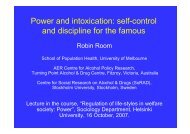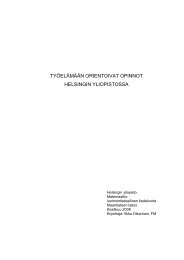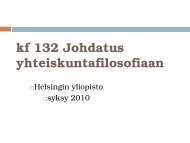Ambio, Vol. 27, No. 2, pp. 112-117
Ambio, Vol. 27, No. 2, pp. 112-117
Ambio, Vol. 27, No. 2, pp. 112-117
- No tags were found...
You also want an ePaper? Increase the reach of your titles
YUMPU automatically turns print PDFs into web optimized ePapers that Google loves.
three decades, one governmental study after another found amaster drain either to the San Francisco Bay-Delta or directlyto the Pacific Ocean to be the best way to dispose of the drainagein the long run (21-24). As the master drain has not beenconstructed, agricultural wastewater has been discharged into theSan Joaquin river or evaporation ponds in the valley. The concentrationof toxic elements in evaporation ponds has led to fishand bird deaths and deformities. Concerns over the potentialdamage that drainage might do in California's ecologically sensitivecoastal areas has made out-of-valley options, such as themaster drain, politically unacceptable to virtually all interestgroups. Attention has shifted to assessing on-farm management,land retirement and various treatment processes. These, however,involve untested technologies and do not guarantee a long-termsalt balance in the valley (25).Legal and contractual responsibility to manage agriculturaldrainage in the valley rests with federal, state and local agencies.However, their primary concern has historically been to securethe viability of agricultural production through the storage,conveyance and distribution of irrigation water to farmers. Drainagehas always been considered a secondary, long-term goal bythese agencies.My co-workers and I began to study California's drainageproblems in 1987, when the toxic discoveries had transformeddrainage from a secondary and distant issue into irrigation officials'primary concern requiring urgent remedies. In 23 interviews,we discovered 90 different and often conflicting technical,economic, social, legal and organizational descriptions ofthe San Joaquin valley drainage problem. As in the Finnish case,the focus of analysis was on the controversy's fundamentalackof convergence over how problems and their causal relationshipswere defined (26, <strong>27</strong>).The interviews indicated that California's irrigation officialsfaced a cognitive dilemma. Efforts by irrigation officials to effectivelymanage drainage, most of all by constructing a masterdrain, would secure agricultural production. But such attemptswould also raise strong o<strong>pp</strong>osition from the environmental communityand urban tax-payers against toxics management and subsidizedirrigated agriculture. <strong>No</strong>t managing drainage would moderatethe political criticism, but eventually lead to extensive landretirement and toxicity problems. Irrigation officials hadcognitively internalized the conflict. Despite their preference fora long-term solution for the entire valley, the officials a<strong>pp</strong>easedtheir critics by publicly announcing no such solution was possible.An example of the internalized conflict is the circular argumentby California's irrigation officials, which is held togetherby the view that both land retirement and efforts to alleviate theeconomic hardships resulting from land retirement are problematic(Fig. 3).As a result of their uneasy walk between avoiding polarizedconflict and reducing the uncertainties of drainage management,irrigation officials could only incrementally manage drainagethrough various short-term remedies. For example, the governmentalSan Joaquin Valley Drainage Program, which investigatedthe problem throughout the 1980s, originally claimed todevelop comprehensive plans for long-term management ofdrainage problems, and recognized that the problems could notin the long run be solved solely in the valley (20). At the sametime, the Program's management and advisory committees directedits staff not to study out-of-valley drainage disposal, whichearlier reports had found to be the only viable long-term solution(28). The irrigation officials' dilemma was found to governevery aspect of drainage management in the valley, fromplanning and design of on-farm irrigation management to resourcemobilization for the decommissioning of toxic evaporationponds (29). The impacts of and barriers to the main policyoptions in California's drainage management are summarized inTable 2.1Figure 3.Land must goBusiness competition Circularbetween large and argument ofout of production. small farms. California'sirrigationofficials.Need to compensatefarmers going out ofbusiness due todrainage problems.Equity problems:who benefits,who pays?TOWARD INSTITUTIONAL REFORMIn both the Finnish and the Californian cases, the institutionalrules of environmental management impose fundamentally conflictingpolicy imperatives upon individual policy makers, whoin turn lack the autonomy to settle the conflict in accordance withtheir honest beliefs. Officials, managers and experts interviewedin the case studies all expressed a clear preference for practicingecologically sustainable management. However, under existinginstitutional boundary conditions, they felt compelled to adhereto localized, short-term and profit-oriented operating assumptionsin policy implementation. Policy makers and managers 'resolved'the resulting dilemma with the cognitively dissonant positionof preaching long-term sustainability while practicingshort-term economics.The unfortunate policy outcomes of the dilemma are slightlydifferent in the two cases. When the environmental issue at handis perceived to be acute, as in the San Joaquin valley drainagecase, policy makers opt for research, development and other suchactivities that give the general public the impression experts aredoing something about the problem. At the same time, they avoidaction-forcing long-term decisions that might raise potentiallydevastating questions about the rationale of continuing an eco-nomic activity that causes serious environmental problems in thefirst place (Table 2). When the environmental issue is not acute,as in the case of Finland's hazardous-waste management, policymakers turn completely away from the issue of long-term environmentalmanagement. Instead, they focus on refming technologiesand administrative procedures that ensure compliance withenvironmental regulations in the short run, but also guaranteethe persistence of a wasteful industrial infrastructure (Table 1).One way of breaking the myopic lock-in between institutionsand mental models is to rewrite the institutional rules in a waythat awards policy makers the autonomy to act upon their be-liefs. In the California case, this would mean administrative separationof the responsibility to manage drainage from the responsibilityto provide irrigation water. Analogously, the prerequisiteof far-sighted waste-management strategy in Finland wouldbe distinct decoupling of implementing and regulatory powers.In practice, this could be achieved either by reallocating authorityamong existing agencies or by creating completely new ones.Administrative decoupling of conflicting interests would haveseveral advantages. (i) It would remove the cognitive basis ofshort-sighted decisions by allowing policy makers to freely crafttheir operating assumptions to match sustainability goals, howeverthey choose to define them. (ii) Administrative autonomywould allow policy makers to actually pursue the sustainabilitygoals without fearing loss of organizational autonomy or professionalposition. (iii) Organizational independence wouldshield policy makers formally devoted to sustainability principlesagainst public criticism about lack of vision, which they areso exposed to when operating under conflicting policy imperatives.The proposed reforms would not make environmental conflictsdisa<strong>pp</strong>ear. Tensions would continue both within the new 'sus-<strong>Ambio</strong> <strong>Vol</strong>. <strong>27</strong>, <strong>No</strong>. 2 March 1998 ? Royal Swedish Academy of Sciences 1998 115http://www.ambio.kva.se


